Finding it hard to get used to your CPAP or bilevel therapy? You're not alone.
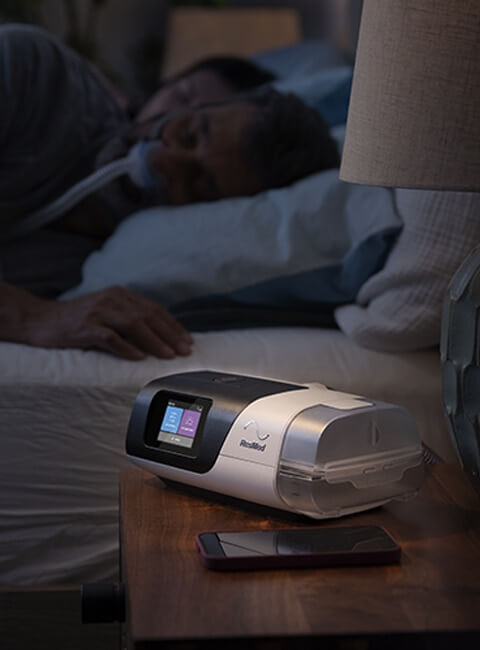
When starting CPAP (continuous positive airway pressure) or another PAP (positive airway pressure) therapy for the first time, or switching from alternative device, everyone is different. Some people adapt quickly, others can take a little longer. If you’re having issues, you’re not alone – we have plenty of suggestions that could help make the process easier.
Still struggling after trying the 3-step approach?
Aside from getting used to the sensation of therapy, you may experience other issues related to your therapy pressure. Some CPAP devices have features that can help with these, outlined below. Speak to your healthcare professional if you think one of these options might help you.
Pressure that increases gradually
If you’re finding it hard to fall asleep while breathing in the full flow of pressurised air, you could try a device with a feature designed to gently ease you into each therapy session. It starts with a low pressure you can get used to as you nod off, then gradually increases the pressure to your prescribed level – by which time you should be asleep!
Pressure that lowers for exhalation
Similarly to the issue just described, some people find it difficult to breathe out against the air pressure from their device – particularly if the therapy pressures are high. In this case you may suit a device that has a feature that gently reduces the pressure when you exhale, to help make it easier to breathe out.
Algorithms that respond to your needs
Not everyone’s air pressure requirements stay the same as they sleep, so it can help with comfort if they use a PAP device that can cater to changes in breathing pattern. In fact, some devices have algorithms that continuously monitor your breathing and will adapt the pressure according to your needs, which may change throughout the night. Please note that only your healthcare professional can actually change the pressure setting parameters of your device.
Mask not complementing your night-time routine?
Match it to your sleep habits
If you’re a front or side-sleeper, tend to move around a lot in the night, or feel claustrophobic with your face covered, the type of mask you use can affect your comfort and therapy. That’s why there are different types of masks designed to suit different sleeping styles and bedtime habits – your doctor or your homecare provider should be able to help you find the right one for your needs.
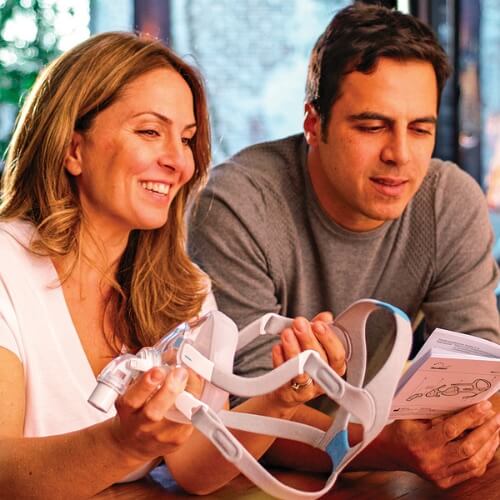
Dry, stuffy nose after using your device?
Adjust the air’s humidity level
It’s possible you may experience side effects from breathing in dry, cold air from your device. These can include a dry throat and mouth or stuffy nose. A humidifier can help avoid this and make therapy more comfortable1 by adding moisture to the air you breath via a small heated water tub. You can also use heated tubing to warm the air and prevent moisture building up in the tube, which could then run towards your face. You can set the humidity level manually, or, if you have a humidifier and heated tubing connected, some PAP devices have the ability to adapt to conditions automatically.
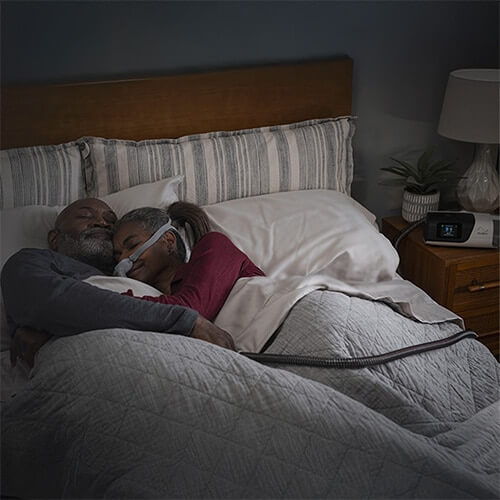
Waiting until you’re nearly asleep to start device?
Start therapy automatically
Picture the scene: you’re settled and comfy in bed, with your CPAP mask on ready to drift off, then realise you need to turn on your device… If you find this disruptive, you could try a device that switches itself on. This way, therapy starts when you put your mask on, so all you need to do is lie back and relax – this feature can also help acclimatise you to therapy and get used to breathing with your mask on.
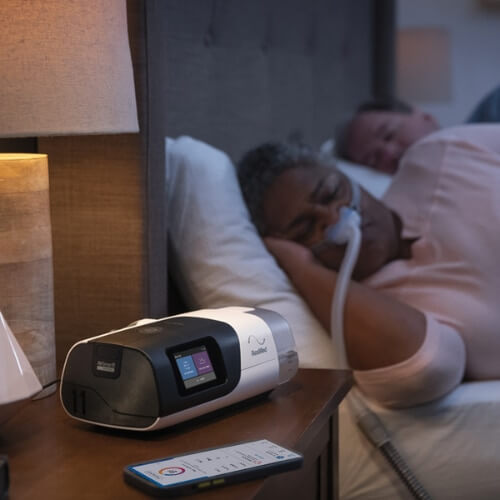
Feeling unmotivated to start or stick to therapy?
Track your progress with an encouraging app
Using a PAP therapy app, like myAir app, could give you a much-needed boost. For example, some devices can be paired with an app to allow you to test different levels of pressure as you start and acclimatise to therapy . Some apps also have features designed to help you keep going with therapy – by setting challenges: each time you meet one, you’ll be rewarded with an achievement badge. The aim is to encourage you to adopt good habits, such as using therapy for at least four hours per night. Some apps even let you combine other health data with your sleep data, as well as check how your therapy’s going and your progress since you started.
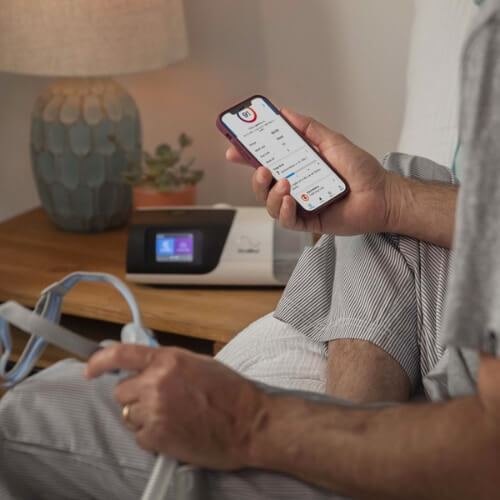
Your device doesn’t seem to work as well as it used to?
Keep your equipment clean and effective
If your therapy started well but now feels like something’s changed, take a look at your cleaning regime (or lack of it!). Are you following the cleaning instructions that came with your device? As well as helping maintain a healthy environment and prevent potential bacteria build-up, keeping your equipment clean aids the performance of your PAP treatment, so it’s important to follow a regular cleaning schedule. This also gives you the chance to check if any components are worn, damaged or otherwise in need of replacement. If you’re sure your equipment is in tip-top condition and something’s still not right, speak to your healthcare professional.
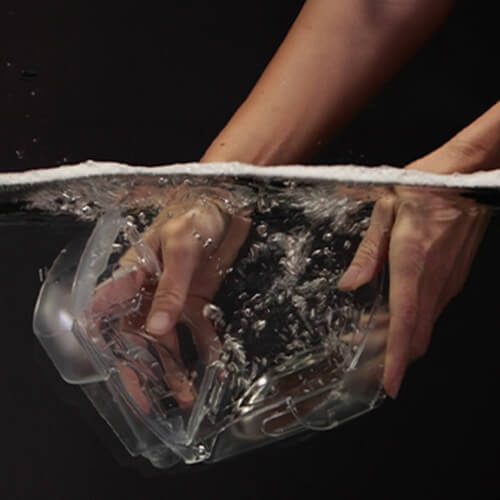
Answers to additional questions you may have:
Studies have shown the majority of people will be using their device consistently within the first month of therapy2,3. However, keep in mind that everyone is different and it can take a little time and practise to get comfortable. Learning to use your therapy equipment is about getting into good habits, staying positive and practising. It also helps to have some support from your doctor, your family and a therapy app.
While you may become more accustomed to using CPAP over time so it feels easier for you, that doesn’t mean it will become less effective over time. It’s like wearing glasses – you don’t necessarily need stronger lenses just because you’ve been wearing them several years. However, your CPAP pressure may need adjustment over time due to changes in weight, ageing, or the development of other health conditions. This will be done and set by your healthcare professional. Remember if you stop using CPAP because you think your sleep apnoea is better, your symptoms will return.
A CPAP (continuous positive airway pressure) machine delivers constant and steady air pressure to you via a mask to help keep your upper airway open while you sleep. This treatment is often used for people with obstructive sleep apnoea (OSA), preventing the airway from collapsing or becoming blocked during sleep. CPAP is considered the gold standard treatment for OSA, helping to reduce symptoms such as snoring and daytime fatigue, and improving overall sleep quality.4
Some people report feeling better and less tired after just one night, while others may take a little longer. If you have a good mask seal and have been using your therapy equipment consistently, you should notice benefits such as a reduction in morning headaches, forgetfulness, poor concentration and tiredness5,6. Some other benefits of CPAP therapy, such as a reduced risk of stroke7, aren’t immediately obvious but are good to think about if you need motivation!
In addition to acclimatising to your air pressure or mask, like any medical treatment CPAP comes with side effects that can make it hard to get used to. These include nasal congestion, a dry nose or mouth, or feeling claustrophobic8. However, as we’ve seen on this page, there are lots of things you can do to help combat these. If it’s noise that’s making it hard for you to sleep with CPAP, take a look at the following question and answer…
If your equipment is noisy, it’s possible that some parts aren’t connected properly. This can result in air leaking out, causing a sound. The first important step is to work out where the noise/leak is coming from: the device itself, heated humidifier, CPAP tubing or mask. Then check everything is connected properly, run the device for a few minutes and listen for a change in noise. If it persists, refer to your mask and/or device user guide for fitting and setup instructions – you may also need to contact your device manufacturer’s customer service department or healthcare provider in case the machine needs repair.
Feeling bloated since starting CPAP therapy could be due to ‘aerophagia’, which occurs when you swallow air that then accumulates in your stomach and intestines. Sleeping on your side instead of your back during therapy may decrease aerophagia. Sleeping on your side may also reduce the pressure level needed to keep your airway open when using an PAP machine, reducing bloating caused by swallowing air. As an added benefit, sleeping on your side is widely considered to help reduce the airway blockages that characterise obstructive sleep apnoea.9 Using a different mask type may also help, so speak to your healthcare provider for personalised advice. They may be able to make adjustments to your therapy that can be beneficial in managing and reducing bloating.10
Put simply, the longer you use your device at night, the more benefits you should see11. Studies have shown that when people use their PAP device for two to three hours each night they still experience benefits12 – but these benefits increase with each extra hour they used the device, up to seven hours12. The general advice is to use the device for at least four hours7 a night, while using it for more than six hours can have benefits for your cardiovascular system7. Of course, as discussed earlier, you can build up to this usage level gradually – so take it slow and steady if you need to.
As explained above, you don’t necessarily have to use your CPAP all night long: the recommended usage time is around four to six hours per night. However, optimal results are often seen when the device is used for the entire duration of sleep, which typically ranges from six to eight hours per night.11,13
If you’re finding it difficult to get through a whole night of therapy, you could try going back to basics and starting wearing your mask for shorter periods and then increasing the amount of time gradually. Some of the other tips in this article may also help. If you are still finding it hard to stay on therapy for prolonged periods, speak to your doctor.
The good news is you can sleep in any position you like when on therapy – however, some masks are more suitable for people who move a lot during the night or sleep on their stomach more than others. Our Starting with the right CPAP mask page will guide you through the options available.
Yes. As described above, you can practise using your CPAP device and mask while you are awake. Some devices can also be paired with an app that allows you to test different pressures to help you acclimatise to them before using overnight.
If you use a nasal or pillows mask, sleeping with your mouth open during PAP therapy isn’t ideal, as it can allow some of the pressurised air you breathe in to escape before it reaches the lungs, making treatment less efficient – known as ‘mouth leak’. This shouldn’t be an issue if you use a full face mask, as this covers your mouth so air can’t escape. If mouth leak occurs, your device might try to push more air out to keep to the prescribed pressure, which could make therapy less comfortable for you. If you still seem to have mouth leak during nasal CPAP therapy, contact your doctor so they can check for nasal obstruction or congestion14. If the problem persists, they may suggest you use a full face mask.
Don’t worry – there are masks that have been specially designed to fit the needs of active sleepers like you. Consult our page about masks for details.
As explained above, there are motivational apps you can use to help you get used to therapy and solve teething troubles by yourself15. These apps can also help you stick to therapy once you get into your PAP routine. Some people also find comfort accessories such as CPAP pillows can also help improve their therapy experience.
Still can’t get used to CPAP?
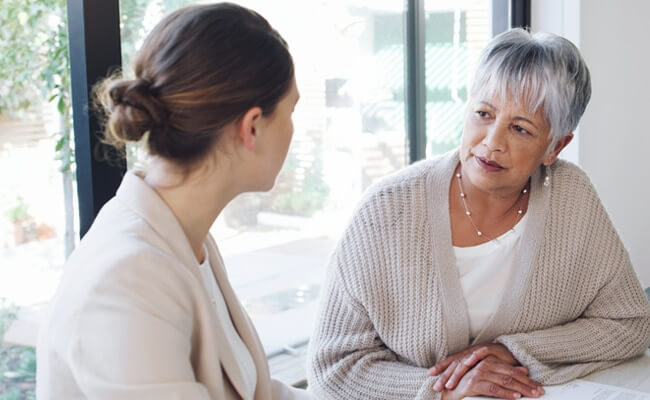
Minor setbacks aside, if you have a good mask seal and use your PAP therapy equipment consistently, you should start to feel benefits in your quality of life and overall health. However, please contact your doctor or care provider for a check-up if:
- your sleep apnoea symptoms persist
- you feel worse than you did when you started therapy
- you’re struggling to adjust to sleeping with your mask on
- you feel like treatment just isn’t working and don’t see the benefits of therapy
- you experience side effects such as irritated or sore skin, eyes, ears, nose or mouth
Tools and tips to help you stay on therapy
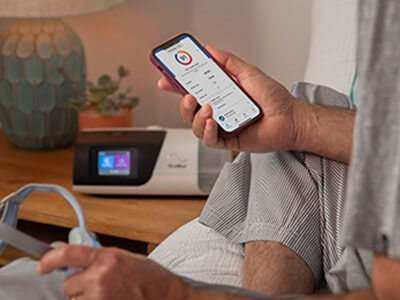
Track your CPAP therapy with myAir
Track your sleep therapy and get personalised advice and assistance on your PAP sleep therapy with the myAir monitoring and coaching app.
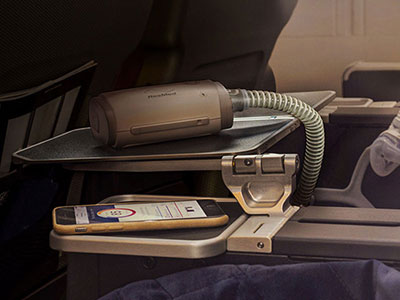
Travel confidently with your CPAP
Read our CPAP travel tips if you’re traveling with sleep apnoea. Learn how to travel safely with your CPAP device and enjoy good sleep away from home.
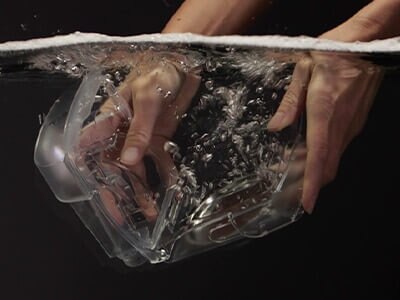
Cleaning your CPAP equipment
Want to ensure your sleep apnoea therapy is as effective as possible? Keeping your CPAP equipment clean will help, so here’s our guide to get you started!
Please refer to the user guides for relevant information related to any contraindications, warnings and precautions to be considered before and during use of the products.
- 1. Patil SP, Ayappa IA, Caples SM, et al. Treatment of Adult Obstructive Sleep Apnea With Positive Airway Pressure: An American Academy of Sleep Medicine Systematic Review, Meta-Analysis, and GRADE Assessment. JCSM 2019;15(2):301-334
- Cistulli PA, Armitstead J, Pepin JL, Woehrle H, Nunez CM, Benjafield A, Malhotra A. Short-term CPAP adherence in obstructive sleep apnea: a big data analysis using real world data. Sleep Med. 2019 Jul;59:114-116. doi: 10.1016/j.sleep.2019.01.004
- Park SI, Kim BK, Lee KE, Hong SD, Jung YG, Kim HY. Predictors for short-term and long-term automatic PAP compliance. J Clin Sleep Med. 2023;19(1):17-26. doi:10.5664/jcsm.10236
- https://www.sleepfoundation.org/cpap/cpap-machine-benefits visited on 02/08/2024
- Wolk R et al. Sleep-disordered breathing and cardiovascular disease. Circulation 2003;108:9–12.
- Palnitkar G et al. Sleep apnoea in adults: identifying risk factors and tailoring therapy. Medicine Today 2012;13(8):14–23.
- Gervès-Pinquié C, Bailly S, Goupil F, et al. Positive Airway Pressure Adherence, Mortality, and Cardiovascular Events in Patients with Sleep Apnea. Am J Respir Crit Care Med. 2022;206(11):1393-1404. doi:10.1164/rccm.202202-0366OC
- Ghadiri M, Grunstein RR. Clinical side effects of continuous positive airway pressure in patients with obstructive sleep apnoea. Respirology. 2020;25(6):593-602. doi:10.1111/resp.13808
- https://www.sleepapnea.org/cpap/aerophagia/, visited on 02/08/2024
- Palot A, Nguyên XL, Launois S, et al. Effect of switching from continuous to bilevel positive airway pressure on sleep quality in patients with obstructive sleep apnea: the prospective POP IN VAuto study. J Thorac Dis. 2023;15(2):918-927. doi:10.21037/jtd-22-825
- Weaver, T.E. and R.R. Grunstein, Adherence to continuous positive airway pressure therapy: the challenge to effective treatment. Proc Am Thorac Soc, 2008. 5(2): p. 173-8. doi:10.1513/pats.200708-119MG
- Malhotra A et al. Dose response relationship between positive airway pressure adherence and clinically important outcomes in patients with obstructive sleep apnea. Oral Presentation at ATS 2022 International Conference; May 18, 2022; San Francisco, CA.
- Sánchez-de-la-Torre M, Gracia-Lavedan E, Benitez ID, et al. Adherence to CPAP Treatment and the Risk of Recurrent Cardiovascular Events: A Meta-Analysis. JAMA. 2023;330(13):1255-1265. doi:10.1001/jama.2023.17465
- Aguilar F, Cisternas A, Montserrat JM, et al. Effect of Nasal Continuous Positive Pressure on the Nostrils of Patients with Sleep Apnea Syndrome and no Previous Nasal Pathology. Predictive Factors for Compliance. Arch Bronconeumol. 2016;52(10):519-526. doi:10.1016/j.arbres.2016.05.007
- Malhotra A, Crocker ME, Willes L, Kelly C, Lynch S, Benjafield AV. Patient Engagement Using New Technology to Improve Adherence to Positive Airway Pressure Therapy: A Retrospective Analysis. Chest. 2018;153(4):843-850. doi:10.1016/j.chest.2017.11.005
Content last updated: 10/2024.